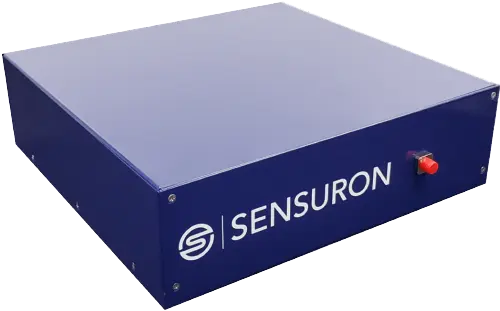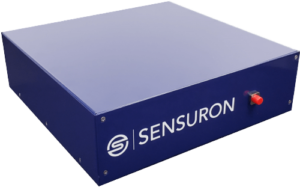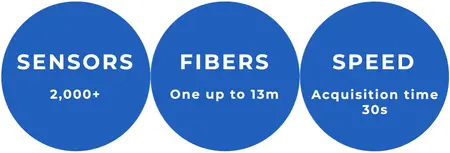Static Strain DFOS System: Affordable Distributed Sensing
Sensuron’s Static Strain DFOS System is a cost-effective one-channel fiber optic sensing instrument for continuous strain monitoring. With over 2,000 sensing points on a single fiber, engineers can achieve spatially continuous strain monitoring.
Static Strain Distributed Fiber Optic Sensing System
Sensuron’s static strain distributed fiber optic sensing system replaces single-point strain sensing systems such as strain gauges to monitor multiple areas simultaneously and produce high-resolution distributed strain profiles.
Customers who replace single-point sensing solutions with a truly distributed sensing platform, such as Sensuron’s RTS250+, RTS125+, and Summit DFOS system, enjoy significantly reduced installation time and labor cost savings. Static strain is a vital tool for Non-Destructive Testing applications.
The Static Strain sensing system costs $16,495 and includes all accessories listed on the datasheet. Sensuron is currently offering a discount of $6,500 for universities and academic institutions.
* Prices and promotional discounts listed are for the United States only.

Importance of strain monitoring in various applications
The importance of strain monitoring cannot be overstated, particularly in critical sectors such as automotive, aerospace, energy, and civil engineering.
The ability to accurately measure and analyze strain is essential for ensuring the structural integrity of aircraft wings, optimizing wind turbine blades’ performance, monitoring bridges’ stability, and enhancing the safety of automotive components.
The Static Strain DFOS System addresses this need by offering engineers an affordable solution for continuous strain monitoring.
This technology empowers engineers to make informed decisions, optimize designs, and ensure the longevity and reliability of their systems by providing detailed data on structural health.
Benefits of Using Sensuron’s Distributed Strain Gauge Sensor
Sensuron’s strain gauge sensor was designed to meet the exacting demands of automotive, aerospace, energy, and civil engineering; this cutting-edge technology offers many benefits over traditional strain monitoring systems.
Leveraging a distributed sensing platform, the Static Strain DFOS System provides engineers unprecedented granularity into structural health and performance.
Sensuron strain gauge sensor’s ability to offer continuous monitoring along the entire length of the optical fiber enables precise and comprehensive strain measurement, even in complex environments.
This level of detail empowers engineers to detect potential issues before they escalate, enabling proactive maintenance and preventing costly downtime.
Additionally, the Static Strain Distributed Fiber Optic Sensing system’s high sensitivity and spatial resolution allow for early detection of anomalies, facilitating predictive maintenance strategies and optimizing operational efficiency.
Overall, Sensuron’s Static Strain DFOS System represents a transformative solution for strain monitoring, offering engineers the tools to enhance safety, reliability, and performance across various applications.
Static Strain Fiber Optic Sensing: Description
Static Strain Fiber Optic Sensing represents a pioneering advancement in structural monitoring technology, offering engineers a comprehensive solution for strain measurement.
Let’s delve into the details of Static Strain sensing, highlighting its unique features and applications.
1. Static Strain as a Low-Cost One-Channel Fiber Optic Sensing System
Static Strain Fiber Optic Sensing stands out as a cost-effective yet highly efficient solution for strain monitoring.
Unlike traditional multi-channel systems, Static Strain operates on one channel, reducing complexity and cost without compromising performance. This system offers unparalleled sensitivity and accuracy by utilizing an optical fiber as the sensing medium while minimizing equipment and installation expenses.
2. Achieving Spatially Continuous Strain Monitoring
One of the critical strengths of Static Strain Fiber Optic Sensing is its ability to achieve spatially continuous strain monitoring. With over 2,000 sensing points on a single fiber, engineers gain unprecedented insight into structural behavior and performance.
This high spatial resolution enables precise localization of strain hotspots and facilitates proactive maintenance strategies, ultimately enhancing structural safety and reliability.
3. Comparison with Traditional Single-Point Strain Sensing Solutions
In contrast to traditional single-point strain sensing solutions such as strain gauges, Static Strain Fiber Optic Sensing offers significant advantages. While strain gauges are limited to discrete point measurements, Static Strain provides continuous strain data along the entire length of the fiber.
This comprehensive coverage eliminates the need for multiple discrete sensors, simplifies installation, and reduces the risk of measurement errors, thereby streamlining the monitoring process and improving overall efficiency.
4. Highlighting the Advantages of Static Strain
Adopting Static Strain and fiber optic sensing brings numerous benefits. Beyond cost-effectiveness, its simplicity reduces installation time and labor costs, making it an attractive choice for large-scale monitoring projects.
Additionally, the continuous monitoring capability allows for early detection of structural anomalies, mitigating risks and minimizing downtime. These advantages position Static Strain as a versatile and indispensable tool for optimizing structural performance across diverse applications.
5. Significance in Non-Destructive Testing Applications
Static Strain Fiber Optic Sensing plays a crucial role in Non-Destructive Testing (NDT) applications, where the integrity of structures must be assessed without causing damage.
By providing detailed and continuous strain data, Static Strain enables engineers to conduct thorough inspections and identify potential defects or weaknesses non-intrusively.
This proactive approach to NDT enhances safety, extends asset lifespan, and reduces maintenance costs, underscoring the importance of Static Strain in ensuring structural integrity and reliability.
STATIC STRAIN FACTS
ADJUSTABLE
The lead length is fully adjustable so users can place the sensor exactly where it needs to be.
REDUCES RISK
Gain confidence in your testing data and model validation. Static Strain’s fully distributed sensing provides the entire picture rather than a handful of data points.
EMI IMMUNE
Fiber Optics Sensing technology does not suffer from electromagnetic interference.
LOW COST
Static strain offers true distributed strain sensing technology at the price level of single point sensors.
Static Strain DFOS System: Features
Empowering engineers with unmatched versatility, our Static Strain DFOS system boasts a comprehensive feature set designed to address the diverse requirements of structural health monitoring applications.
Here’s a closer look at the key specifications:
- One monitored optical fiber with over 2,000 equally spaced sensors
- Sensing length up to 13m
- Software selectable spatial resolution as low as 6.4 mm
- High-resolution distributed strain measurements
- Acquisition time once every 30 seconds
Sensors immune to EMI/RFI and radiation for reliable operation in demanding environments - Low latency networking capability
- Adjustable sensor standoff length

Static Strain Optical Fiber Sensor: Applications
Sensuron’s Static Strain Sensing System unlocks many possibilities across many engineering applications. Our system is a valuable tool for various structural health monitoring applications.
Let’s explore how our Static Strain system benefits these key sectors.
Automotive
Static Strain in automotive applications
Perform static tests to monitor body panels, frame components, seat impact deflection, and more.
Aerospace
Static Strain in aerospace applications
From structural health monitoring to improving aircraft component designs.
Energy
Static Strain in energy applications
Monitor turbine blade and nuclear plant tool shape, as well as the integrity of rigs and subsea risers.
Civil Engineering
Static Strain in civil engineering applications
Sensuron’s distributed sensing technology has transformed and evolved the methods used for design validation and ongoing structural health testing.
Static Strain Optical Fiber Sensing: Summary

Sensuron’s Static Strain DFOS System stands ready to meet the distributed strain monitoring needs of engineers in the automotive, aerospace, energy, and civil engineering industries.
This innovative system offers a cost-effective solution without compromising performance, providing engineers with over 2,000 sensing points on a single fiber for spatially continuous strain monitoring.
The benefits of Static Strain are numerous, from streamlined installation processes to enhanced structural safety and reliability. Its application in Non-Destructive Testing further solidifies its role as an indispensable tool in ensuring structural integrity.
Recognizing the importance of fostering academic progress and research, we extend a generous discount of $6,500 to universities and academic institutions, making this advanced technology accessible to future leaders of engineering innovations.
Contact Sensuron and our team will discuss how your application can benefit from static strain fiber optic sensing technology.
